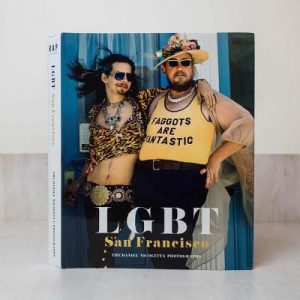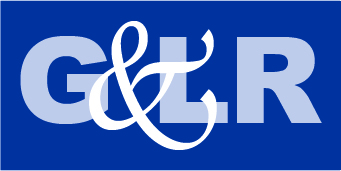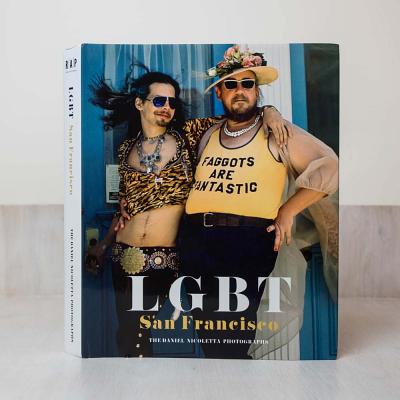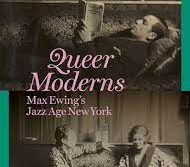 LGBT San Francisco: The Daniel Nicoletta Photographs
LGBT San Francisco: The Daniel Nicoletta Photographs
by Daniel Nicoletta
Reel Art Press. 304 pages, $60.
MIGRATION is about survival. For centuries in America, LGBT people migrated northward, westward, and eastward from small towns to urban centers, forming “out” communities, constructing intellectually creative and meaningful work, and advocating for political and social rights. Heterogeneous LGBT subcultures emerged in urban neighborhoods—in Greenwich Village, West Hollywood, Boston’s South End, Chicago’s Northside, Philadelphia’s Center City, and San Francisco’s Castro Street. This migration has not been quantifiable, because census data did not include questions about sexual orientation or gender identity. Due to the striking deficiency of research and demographic statistics about LGBT migration, a discourse termed queer diaspora scholarship has developed within academia to examine this problem.
During the half century before World War II, New York and San Francisco developed concurrently as destinations for LGBT people, as places both to live and visit. In the 1950s, San Francisco was an emerging LGBT hub, with growing “homophile” organizations such as the Mattachine Society and Daughters of Bilitis. In the 1970s, many New Yorkers, including Harvey Milk, migrated to San Francisco, which had a long history of sex and gender-nonconformity, cross-gender performance, and a bohemian subculture. A cadre of Gay Liberation Front (GLF) and Gay Activist Alliance (GAA) members, many of whom changed their names and constructed more fluid identities in “Sodom by the Sea,” were enticed by San Francisco’s countercultural allure. Attractions included the hypermasculine subculture exemplified by Drummer magazine and the bars on Folsom Street; theatricality and the gender-bending antics of the Cockettes or the Sisters of Perpetual Indulgence; the tribalism of the Radical Faeries; and, later, the AIDS activism of the 1980s. LGBT San Francisco: The Daniel Nicoletta Photographs may be seen as a photojournalistic companion to Gus Van Sant’s Milk and Dustin Lance Black’s When We Rise. Its images portray a milieu of turbulence and exuberance and powerful waves of grassroots political activism. It was against that backdrop that Daniel “Danny” Nicoletta moved to San Francisco’s Castro in 1974. Photography is thematic in Milk as much as it is at the core of Hitchcock’s Rear Window or Antonioni’s Blow-Up. The titles alone give a good idea of the eclectic content of this book: Larry Piet’s Valentine Art Installation, Castro Camera, February 1977; Self-Portrait in Ashbury Street Darkroom, 1977; Castro Street Fair, August 1976, which is paired with Harvey in Front of His Castro Street Camera Store, circa 1977; Milk: Lukas Grabeel as Dan Nicoletta, February 1, 2008; and The San Francisco Gay Men’s Chorus Sings at the Dedication of the Harvey Milk US Postage Stamp at SF City Hall,” May 28, 2014. In the forward to LGBT San Francisco, Van Sant acknowledges Nicoletta’s contribution to the visual accuracy of Milk: “Danny’s photographs were a vital resource to the formation of Milk.” His photos of the filming of Milk are an official record of the shoot that take on a “meta” quality given Nicoletta’s contribution to the movie’s look and atmosphere. Art historian Graham Clark once wrote: “Rather than the notion of looking, which suggests a passive act of recognition, we need to insist that we read a photograph, not as an image, but as a text.” Nicoletta’s images in LGBT San Francisco can be read as an epic narrative: not a static moment but an unfolding drama. There are images of Sean Penn and Harvey Milk placed side-by-side, and there are juxtaposed reenactments such as: Supervisor Harvey Milk’s Inaugural Walk from Castro Street to City Hall, with His Lover Jack Lira and Supporters, January 9, 1978; Milk: Inaugural Walk re-enactment, March 22, 2008; Ron and Sandy Severini from Ringling Bros. and Barnum & Bailey Clown School Prepare Harvey for an Editorial in California Living Magazine about the Circus; and Milk: Sean Penn as Harvey Getting Made Up by Ringling Bros. and Barnum & Bailey Clowns, March 14, 2008. Nicoletta’s work underscores the social function of photographs, drawing the reader to the image through codes, gestures, clothing, hair, and mingled artifacts of the LGBT subculture. Through the diversity of his subjects, Nicoletta asserts that the components of “LGBT” are holding together in various iterations and permutations across a wide range of identities and orientations. Steven F. Dansky, an activist, photographer, and writer for over fifty years, is the director of Outspoken: Oral History from lgbtq Pioneers.





